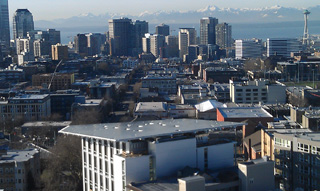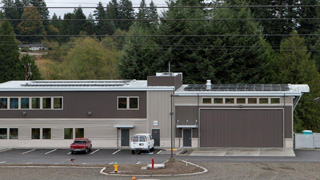|
Subscribe / Renew |
|
|
Contact Us |
|
| ► Subscribe to our Free Weekly Newsletter | |
| home | Welcome, sign in or click here to subscribe. | login |
Environment
| |
 |
February 28, 2013
Falling costs could mean a bright future for solar panels
Northwest Wind & Solar

Charap
|
The Bullitt Center is a net-zero energy facility in Seattle that uses a 244-kilowatt rooftop photovoltaic system to generate as much electricity as the building and its tenants will use each year.
While admirable, few building owners are able to achieve the net-zero threshold. Most renewable-energy system owners or investors make their contribution with a supplemental offset sized within a budget or availability of roof area.
Solar photovoltaics, or PV, are considered a longer-term corporate investment. But when avoided costs and incentives are analyzed, going solar, even in Western Washington, is a very sound economic decision.
PV benefits
Solar panels produce electricity for decades. Most are guaranteed to produce a minimum of 80 percent of their rated power for 25 years.
As a solid-state system with no moving parts, PV is low maintenance, and when installed properly, history has proven it to be a reliable power source for well beyond the warranty period. While Western Washington does not receive the most sun, our climate does complement solar PV in a number of ways: rain provides self-cleaning, the cooler temperatures increase efficiency, and utility net metering programs allow customers to credit kilowatt hours during our long, sunny summer days, which can then be used through winter.
Facility operators are accustomed to paying monthly utility bills. Washington’s market typically requires upfront payment, or financing, so investing in 30 to 40 years of energy upfront is a different approach for the general public. It is an approach however, that continues to grow in popularity as rates continue to increase, and utility customers are looking for ways to reduce their long-term operating costs.
Energy efficiency and cost of ownership are highly important considerations to today’s consumers. Paying an initial premium for a better-performing asset with long-term savings is a wise buying alternative. Furthermore, installed system costs have become surprisingly low.
Like all technologies, as adoption becomes more widespread, prices decline. Solar panel prices realized substantial reductions over the last two years due to many global market influences.
While artificially low prices are catastrophic for manufacturers, they do offer opportunities for end users. Complete commercial systems are currently sold for under $3 a watt with a high-quality domestic panel like SolarWorld. Additional marginal savings can be had with imported options. Installed prices for commercial PV systems are half the cost they were in Washington a few years ago.
Cost incentives
Incentives are available to help reduce upfront cost. Washington provides an annual production incentive to support customer adoption and promote made-in-Washington equipment on small systems.
Federal and state governments recognize the benefits of customer-owned distributed generation and domestic clean energy markets so they subsidize their costs against traditional energy sources whose true plant costs and impacts are not associated with the monthly power bill to ratepayers.
Here is a list of available incentives in Washington with their current expiration dates:
• 30 percent Federal Business Energy Investment Tax Credit (expires end of 2016)
• 75 percent state sales tax exemption (expires on June 30)
• MACRS depreciation (expires end of 2013)
• Washington production incentive, up to $5,000 per year (expires on June 30, 2020)
For more details, see www.dsireusa.org/incentives.
Success stories
Local business owners have checked the math and found solar PV is a sound investment.
Kemp West is a vegetation management company serving utility and municipal customers throughout the Northwest. The company built a 6,000-square-foot commercial office and maintenance facility in Snohomish and installed a 31-kilowatt PV system.
Company owner Kari Hakso carefully analyzed the investment, studied the long-term return and incentives available through the Snohomish County PUD, the state of Washington and the federal government. All those factors made the solar system a very sensible financial decision for the company.
The state pays a production incentive of 15 cents per kilowatt hour for a system using equipment manufactured out of state. This system will nearly reach the $5,000 per year of production incentive. As a commercial business, the project qualifies for a 75 percent sales tax reduction. Finally, there is a 30 percent federal income tax credit on the entire installed cost, with the remainder of the cost then being eligible for accelerated depreciation.
With all of these incentives factored in, the system will pay for itself in seven years, then offer paid-for electricity at the going rate for the remaining 30- or 40-year life of the system.
Johnson Braund’s architectural offices in Tukwila installed a 10-kilowatt PV system in 2007. They added a 3-kilowatt expansion in 2011, and the combined systems cover approximately 25 percent of the electricity needs. The firm has also significantly reduced their water consumption and energy use.
The two most common questions related to solar PV: What is the return on investment? And does solar work in Western Washington?
The answers: In many cases ROI is as little as seven years. And yes, solar works in Western Washington.
In the case of the Bullitt Center, rooftop solar will provide all annual electricity needs for a six-story commercial building in Seattle.
Kevin Charap is the design and installation manager for Northwest Wind & Solar in Seattle.
Other Stories:
- Don’t let green-minded clients leave you behind
- New transfer station lifts Makahs out of the dumps
- Engineering school’s new home reflects its values
- Is LEED’s future with federal projects under threat?
- A crucial step that green building teams often skip
- Thermal ‘ravioli’ keeps building temps in check
- Bullitt neighbor seeks a green distinction of its own
- How contractors can make the supply chain greener
- What to look for in a green building




